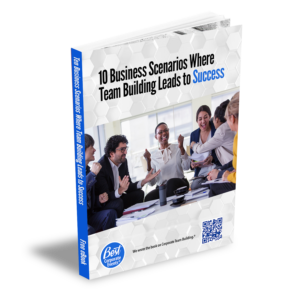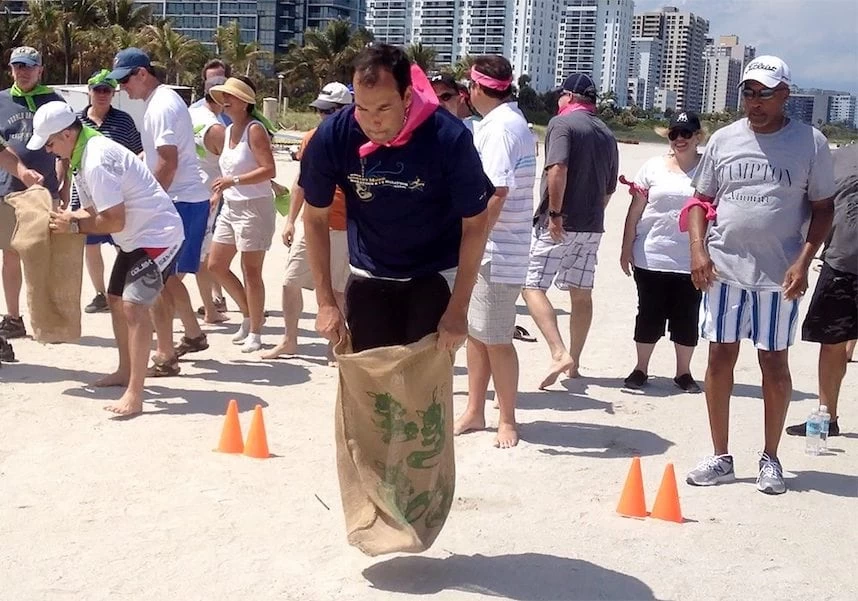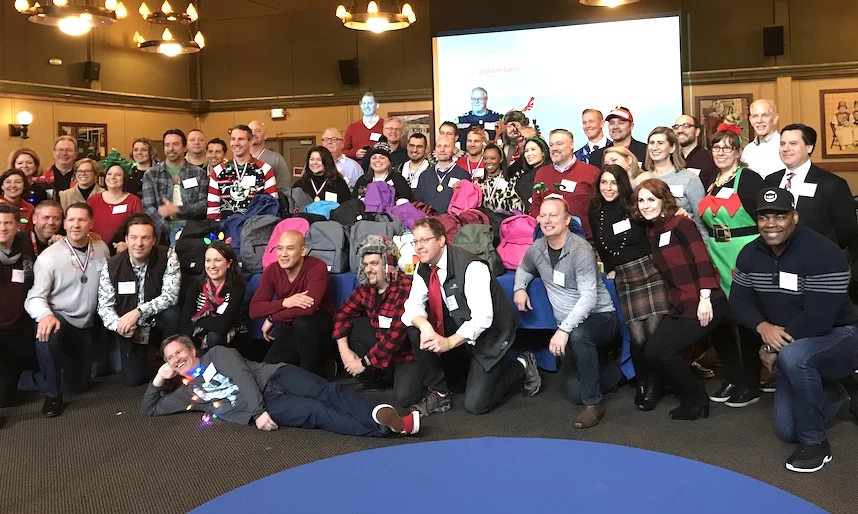Team building activities have come a long way from the days of “trust falls” (trite), ropes courses (dangerous), and paintball (just a really bad idea). Today’s team building is serious business, delivering measurable results in terms of improved and increased collaboration, employee engagement, and productivity.
This post will define and detail:
- the pillars of modern corporate team building activities;
- the benefits of team building;
- key components, roles, and strategies for effective team building;
- how to choose the right activities;
- the types of effective programs; and
- how to measure the benefits of team building activities.
Equipped with this knowledge, you’ll be able to select the right activity and partner to help achieve your immediate business goals, as well as build a culture of high performance over the long term.
What Is Team Building?
Professional corporate team building is an intentional, organized activity designed to achieve specific business goals and incorporates six core pillars of all team building programs:
- Communication
- Collaboration
- Problem-solving
- Relationship building
- Leadership
- Fun!
As more and more basic, repetitive, individual tasks become automated by business process software or even AI technology, employees are spending increasing amounts of time working within collaborative teams on vital high-level strategic and creative work processes.
In this environment, team building activities are an essential component of management, helping members of diverse and often spatially separate team members build strong relationships and trust, enabling them to perform more efficiently and effectively together.
Enterprises that make team building a regular, recurring activity are better positioned to attract, retain, and engage top talent, building a durable culture of high performance over time.
Benefits of Team Building
As detailed in previous posts on this blog, team building activities increase employee engagement, positively impact employee loyalty, jumpstart employee morale, improve productivity (for both current and new employees), and, as noted above, help to build a culture of high performance.
Numerous studies have quantified the value of team building activities. For example:
- Team building events increase employee engagement, and according to Forbes, “organizations with highly engaged teams show 21% greater profitability…teams who score in the top 20% in engagement realize a 41% reduction in absenteeism, and 59% less turnover.”
- Team building improves communication and demonstrates a commitment to employees by investing in improving their collaboration, leadership, and problem-solving skills. “Employees who feel their voice is heard are 4.6 times more likely to feel empowered to perform their best work,” per Forbes.
- Team building activities help build strong workplace relationships and support employee well-being. And again, per Forbes, “89% of workers at companies that support well-being initiatives are more likely to recommend their company as a good place to work…(but) In organizations where employees do not view leadership as committed to their well-being, only 17% would recommend the company as a good place to work.”
- Finally, per Gomada, “Over 80% of employers and employees believe that creating a sense of community at work is important”—and creating a sense of community is definitely one of the key objectives of team building. Furthermore, “37% of the employees say that they stay in their current job because they are working with a great team. Teamwork statistics also show that 52% of workers have left a job or considered leaving because they felt like they didn’t belong.”
To maximize the benefits of team building, it’s crucial to choose a partner that will assess your needs and customize a team building activity to meet your goals, and that combines the resources of a large company to deliver team building programs anywhere in the U.S. with the personal attention to detail of a small company. These are just three of the key qualities of an ideal team building partner.
Key Components of Team Building
Clearly, team building activities have the potential to deliver significant benefits to employees and the organizations they work for. But to realize a return on the investment, it’s vital that team building events incorporate these seven essential elements:
- An activity aligned with business goals.
Although all professional team building programs include the pillars described above, different activities fit best in different business scenarios. For example, in situations where you want to introduce a lot of new employees—such as during a period of rapid growth or the merger of two companies—an activity like Speed Networking would be ideal. If, on the other hand, your goal is to improve collaboration within or across existing teams, though Speed Networking might still be fun, there are other programs that would be more effective and appropriate.
That’s why every team building project should start with a needs assessment to help match, or even customize, a program to meet your specific business goals.
- The right venue for the activity.
Most team building activities take place indoors. Make sure the venue is conducive to a productive event: adequate space, comfortable, with a reliable sound system, and minimal distractions. Keep these considerations in mind when choosing the best venue for your team building event. If you really want to be outdoors, be sure to check the weather, arrange transportation, and have a backup plan.
- An expert, experienced facilitator.
This person can make or break the success of your event. Make sure your facilitator is adept at all the different roles he or she will play during the activity, is able to answer all of your questions, and, even more importantly, asks you pertinent questions to prepare for your activity.
- The right team building partner.
Make sure to choose a partner that offers a variety of programs to fit different business goals and provides excellent customer service, in terms of both the supporting technology they provide and the personal touch. If you are planning a charitable corporate social responsibility (CSR) activity, make sure the vendor has the inventory on hand to support your program as well as established relationships with a range of nonprofit organizations.
- An inclusive activity.
Every one of your employees is a unique individual. One may run marathons, while another has mobility challenges. Make sure your event is designed with different roles so that everyone can be involved (another reason to rule out paintball and ropes courses).
- A truly collaborative event.
Again, because each of your employees is unique, some may have “take charge” personalities while others are more introverted. Team building programs are only truly effective when everyone actually collaborates. One of the skills your facilitator should have is recognizing when someone may not feel involved in the activity and gently stepping in to help get them involved.
- Fun!
Although team building provides serious business benefits, participating in the activity should be enjoyable. You should see a lot of smiles and hear laughter. Team building isn’t effective if employees view it as a chore or as boring, uncomfortable, or pointless.
Keeping these seven essential elements in mind will help ensure the success of your team building efforts.
Roles in Team Building
Because every employee is a unique individual, each brings specific strengths and capabilities to team building. Depending upon the specific activity, individual team members may play any of half a dozen different roles.
Timekeeper:
In activities that are time-bound, such as A Minute 2 Win It!, it helps to have one person watching the time closely and keeping the team informed of the time remaining.
Team leader:
It often helps to have one person in charge of coordinating the actions of group members. Because one of the objectives of team building generally is to teach leadership skills, the team leader, in this case, shouldn’t necessarily be the highest-ranking person based on the company org chart.
Specialist:
Depending upon the activity, a “specialist” may be someone who is adept with using a specific tool, knowledgeable in a certain trivia subject category, has a great sense of direction, or brings some other unique skill to a team role.
Recorder:
In activities like City SmartHunts, the group may want to put one team member in charge of taking most of the photos and videos required.
Arbitrator:
Again, depending on the activity, a team may want to choose one individual to be in charge of helping to quickly and fairly resolve disputes or disagreements between team members.
Coordinator:
In team building activities where the output of one group needs to mesh seamlessly with the output of another group—such as Pipeline, Momentum, or Bridge to the Future—groups may want to assign a coordinator to help ensure those outputs match up.
Just as in the workplace, recognizing and utilizing individual strengths within a team can help it perform more effectively. But at the same time, it’s important to use team building activities as an opportunity for individual team members to “stretch” a bit.
For example, putting someone in the role of leader or arbitrator who doesn’t normally use that skill at work gives them the chance to explore their abilities in a risk-free setting.
Strategies for Effective Team Building
Different strategies can be employed to help foster team unity, cohesion, and collaboration. Before jumping into a team building activity, consider these approaches:
Form teams strategically:
Consider the business goals when determining how teams will be formed. In some cases, it may work best to have teams within a function (e.g., sales teams from different regions) compete against each other. In other cases, achieving the business goal may be better served by mixing up functions (e.g., every team includes members from finance, production, quality assurance, and shipping).
Set clear goals:
Most team building activities have an element of competition to them, one goal is simply “to win.” For example, in the Build-a-Raft Competition, teams are challenged to design, build, and captain crafts that are not only buoyant but also the fastest.
But there are also typically company goals (e.g., improve cross-departmental communication) and specific team goals (get sales to work more collaboratively with customer service) to keep in mind. When everyone understands the goals up front, they are more likely to achieve them.
Assign roles:
As noted above, it’s often helpful to match people with specific team roles, such as timekeeper or recorder. This won’t always be necessary, and the specific roles to fill vary based on the type of activity, but when skills can be matched to tasks it helps the team succeed.
Be inclusive:
Teams work best when everyone is involved regardless of personality traits, physical condition, or other attributes. When individuals are able to apply their unique skills to helping the team achieve goals and prevail in competition, everyone wins.
Encourage open communication:
True inclusivity is only possible when every member of the team is encouraged and feels empowered to communicate openly and freely. In situations where a manager or supervisor is part of the team, that person needs to make a conscious effort to be “just part of the team” within the team building exercise.
Debrief at the end:
Spend some time at the conclusion of the team building activity talking about it. What did the participants learn? What new ideas or approaches will they bring back into the workplace? How has their outlook or perception of a business problem or opportunity changed? This is vital in clarifying and reinforcing the lessons from the event.
One example of a leading company employing these strategies was the Build-a-Wheelchair® CSR program done by Dominion Energy. It’s clear from the video that these teams were working collaboratively, communicating openly, including everyone on the team, and working with a clear goal and purpose (in this case, assembling wheelchairs for disabled veterans). And they were also, incidentally, clearly having fun!
How to Choose the Right Team Building Activities for Your Team
The first step in organizing a team building activity that works is, of course, choosing the right activity or program.
The overall group size and time allotted are two key pieces of information to share with your team building partner right up front—though most activities can generally be scaled up or down for almost any group size (for example, when Lowes did the largest charitable bike build in history, where 3,400 managers assembled more than 1,000 bikes for deserving kids), and expanded or condensed to fill the available time.
The most important consideration in choosing the right activity is your underlying business purpose. If your business objective is helping employees adjust to a major change in organizational structure, for example, you would likely choose from a different subset of team building activities than if your goal was to improve cross-departmental collaboration, integrate remote teams, or celebrate a company achievement.
While purpose will be the biggest driver, other factors to consider include:
Venue:
As with group size and time available, the choice of venue generally won’t play a major role in team building activity selection. But it is an important consideration in certain circumstances; for example, build-type activities generally require more space than trivia or game shows. And you probably wouldn’t want to do a City SmartHunt outdoors in Minneapolis in January.
Virtual vs. In-Person:
Activities like game shows, murder mysteries, trivia challenges, (virtual) escape rooms, and even some professional development workshops work just as well online as in-person. But other programs, like CSR build-type activities…not so much.
Budget:
While cost is always “a” consideration in any corporate procurement decision, from staplers to software, it’s rarely the deciding factor. When selecting a team building activity, the relative cost of different options is important to know, but will generally play a small part in the final decision.
List of Effective Team Building Activities
Any professional team building activity can be successful if appropriately matched to your business goals and objectives. But often, there are several options that will correlate well with your needs. Before considering specific activities, it’s helpful to explore these seven different categories of programs—and then look for the best activity within that group.
Charitable CSR Activities
These programs not only deliver on all of the pillars of professional corporate team building as defined above, but also benefit your local community, enhance your corporate brand, and create powerful shared emotional experiences that enhance employee engagement and retention. Numerous research studies show the value of CSR programs.
What’s more, there are programs available to address a wide range of causes and groups, from children to the homeless, hungry, and mobility challenged. A few of the many programs available include:
- Build-a-Guitar®: Corporate teams assemble guitars from custom-designed kits to donate to teens through schools and youth organizations.
- Earth Wind and Solar: This program combines the engaging experience of building and racing solar-powered vehicles with a donation that will spark children’s curiosity and exposure to STEM.
- Mini-Golf Build and Food Donation: Teams use canned and boxed food items to design a mini golf course, play the holes, and then donate the food items to a local food bank or similar organization.
Game Shows
Expert facilitator “hosts” use state-of-the-art game show equipment, sound, and visuals to create a fun and engaging experience that tests the knowledge and skills of participants in activities like Best Corporate Feud, Jeoparody Live!, and Match Me If You Can.
Team Building Activities
These programs improve communication, collaboration, trust, and cohesiveness while strengthening interpersonal and problem-solving skills.
The wide variety of exercises in this category range from our Go-Kart Competition and Race Car Rally to Igniting Team Performance® (a progressive series of engaging initiatives followed by rich processing discussions focused on high-performing teams) and Competition to Collaboration® (where teams first compete in various challenges, then collaborate to increase the total score for all teams).
Escape Rooms and Murder Mysteries
Mystery programs like Crack the Case! and Mavericks Murder Mystery challenge the reasoning, collaboration, creative thinking, and problem-solving skills of participants. Virtual escape rooms and activities like our three-part Virtual Treasure Hunt series (The Cave, The Heist, and The Treasure) combine an immersive storyline with rich graphics and clues of varying types and difficulty to create an engaging team challenge.
SmartHunts®
Going way beyond traditional scavenger hunts, these activities range from interactive technology-driven City Smarthunts, which can be conducted in virtually any major metropolitan area across the U.S., to an Escape SmartHunt (which layers on additional puzzles and challenges), to our Locate and Donate SmartHunt, which adds a charitable CSR dimension.
Virtual Events
Beyond our virtual escape room programs and mysteries, most game shows can be delivered online as well as in person, as can many professional development workshops, including several specifically designed for remote teams, including Building Your Hybrid Team, Conducting Better Virtual Meetings, and Leading Virtual Teams.
Measuring the Impact
As with any investment of company funds, it’s important to look at the return, to measure the success of team building activities.
We’ve covered that in detail previously on this blog, but again, three key mechanisms that can be used to gauge effectiveness are:
Employee feedback:
One of the best ways to measure the impact of team building activities is simply to ask (survey) the employees who were involved. Did they find it worthwhile? Why or why not? What specifically did they learn or take away from the activity? How did it impact the way they work? Would they like to do it again? Presuming that’s a “yes,” what—if anything—would they like to see done differently?
Use a series of questions, digging into detail, to determine what was accomplished from the perspective of those who took part.
Customer feedback:
This won’t be applicable in every situation, but in any scenario where the employees who participated were customer-facing—or were leaders of people who are customer-facing—is there any difference in customer satisfaction post-event? Consider star ratings, net promoter scores, customer survey responses, and the tone of comments.
Employee attendance and retention:
A key benefit of team building is increased employee engagement. This can be measured, on a before-and-after basis, through measures like attendance, punctuality, and retention, as well as through surveys measuring employee satisfaction and likelihood to recommend the company to other job seekers.
Final Thoughts on Effective Team Building Activities
Long gone are the days of “trust falls” and other types of team building exercises that were inappropriate or even dangerous. Today’s team building activities are based on psychology; developed and refined to improve collaboration and problem-solving skills; and designed to be inclusive and fun for everyone.
Multiple research studies have shown that team building activities measurably increase employee engagement and enhance workplace relationships. They ultimately help produce higher productivity, reduce absenteeism and turnover, and increase profitability.
While all team building programs include core pillars like communication and relationship building, different types of activities emphasize different skills. Escape rooms and murder mysteries focus on problem-solving; collaborative team building activities build teamwork and coordination; and CSR programs help the local community while enhancing employee loyalty and creating emotionally powerful shared experiences.
Team building exercises are most effective when they align with clear business goals, are inclusive, encourage open communication, and conclude with a debriefing session that reinforces key takeaways from the activity. Among the key components are choosing the right venue, an expert facilitator, and the best team building partner for your event.
Subscribe to the Best Corporate Events blog to get notifications when upcoming posts are published, revealing what the best places to work have in common, how to maximize team cohesion with differing personality types, how corporate team building differs from other types of team building, and much more.
Planning a team building event? Contact us to discuss a business needs assessment and how we can customize a program to meet your specific goals.






